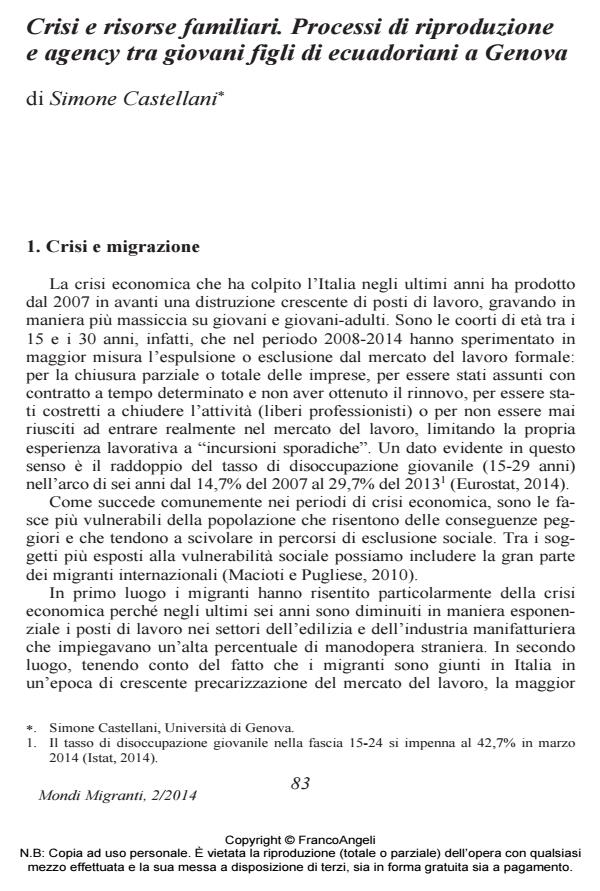Crisis and Family Resources. Processes of Reproduction and Agency among Young Ecuadorians’ Children in Genoa
Journal title MONDI MIGRANTI
Author/s Simone Castellani
Publishing Year 2014 Issue 2014/2
Language Italian Pages 22 P. 83-104 File size 78 KB
DOI 10.3280/MM2014-002005
DOI is like a bar code for intellectual property: to have more infomation
click here
Below, you can see the article first page
If you want to buy this article in PDF format, you can do it, following the instructions to buy download credits

FrancoAngeli is member of Publishers International Linking Association, Inc (PILA), a not-for-profit association which run the CrossRef service enabling links to and from online scholarly content.
The young Italian people, who have been heavily affected by the increasing unemployment due to the present economic crisis in the global North, have been generating different responses depending on gender, ethnicity and social class. Starting from the empirical data collected in an ethnographic fieldwork which involved Ecuadorians’ teenage children who lived in the neighborhood of Sampierdarena in Genoa, the paper reflects on how the condition of youngsters is correlated with the migrant condition. Through the observation of the teenagers’ different spheres of socialization (domestic group, peer group and school) the article displays that the Ecuadorian migrants’ children face the crisis in different ways as do the "autochthonous" peers of the same social-economic condition who live in the neighborhood. The analysis shows how the pattern of adaptation of these teenagers regarding the difficulties of the contemporary socio-historical context cannot be separated from their belonging to a domestic group engaged in a transnational migration project. Nevertheless, the paper displays how the reproduction of the domestic group always maintain a dialectical relationship with the agency of these young people who are active subjects facing the crisis.
Keywords: Crisis, youth, agency, Ecuador, family, reproduction.
- Between Pleasure and Resistance: The Role of Substance Consumption in an Italian Working-Class Subculture Matteo Di Placido, in Societies /2019 pp.58
DOI: 10.3390/soc9030058 - The unseen protagonists. Ecuadorians’ daughters between Ecuador and Southern Europe Francesca Lagomarsino, Simone Castellani, in Social Identities /2016 pp.291
DOI: 10.1080/13504630.2015.1128813
Simone Castellani, Crisi e risorse familiari. Processi di riproduzione e agency tra giovani figli di ecuadoriani a Genova in "MONDI MIGRANTI" 2/2014, pp 83-104, DOI: 10.3280/MM2014-002005